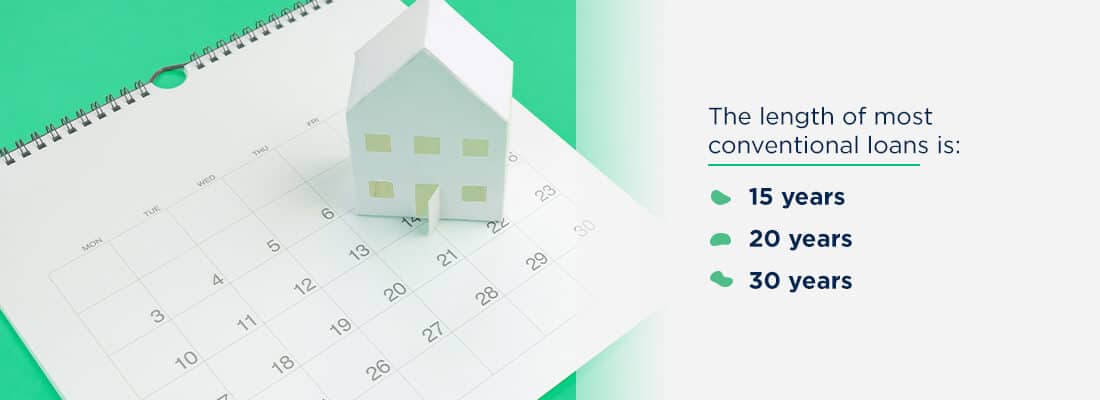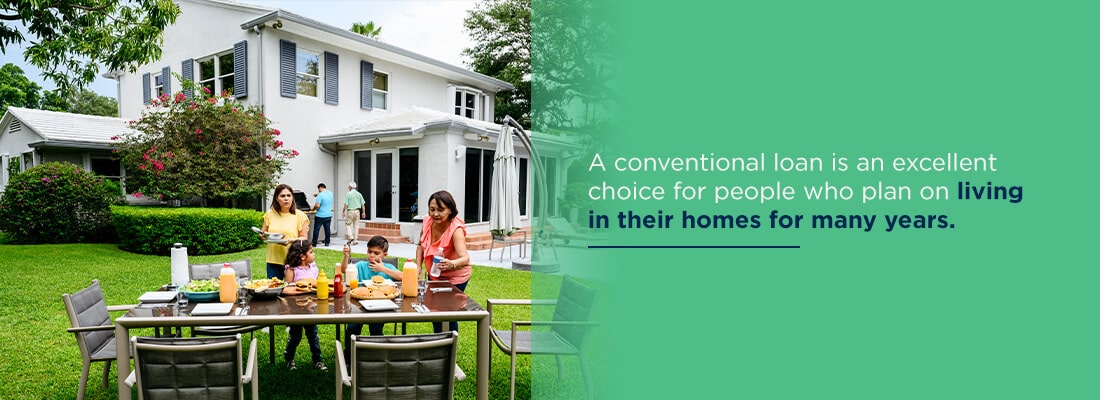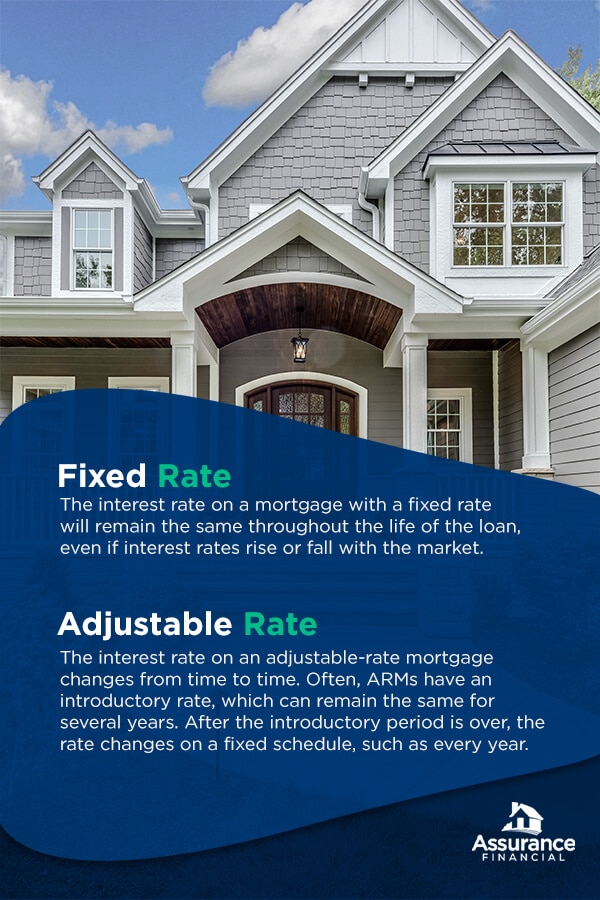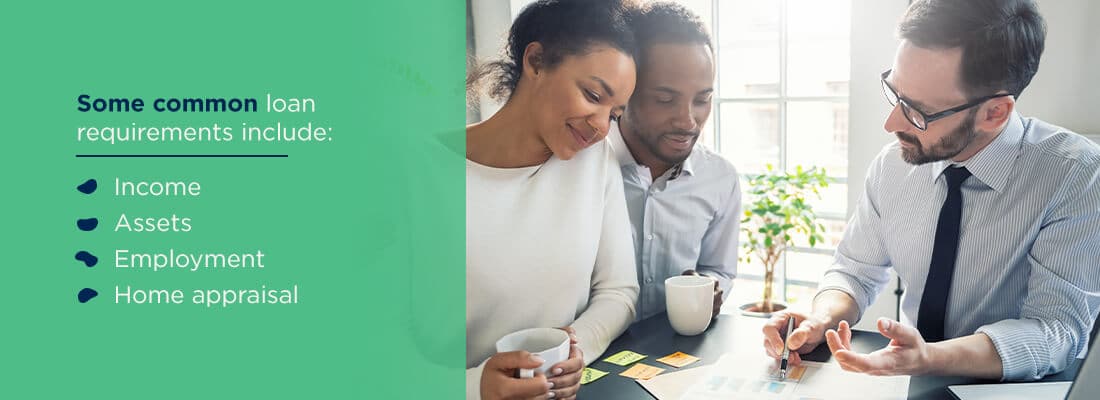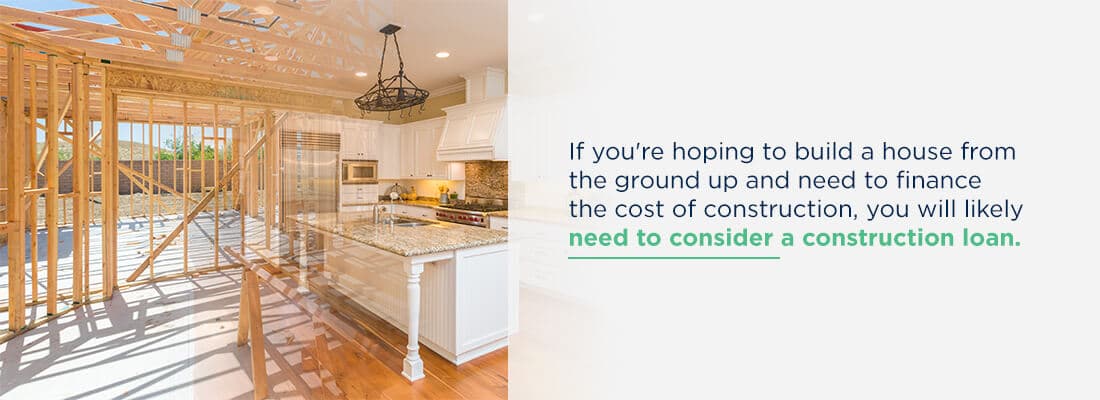The most common type of home loan is the conventional loan. These loans are perfect for borrowers with a strong credit history and the funds for a more substantial down payment. Conventional loans offer the ability to avoid the costs of mortgage insurance while also giving borrowers the option of fixed or adjustable rates.
- What are conventional loan limits?
- Is a conventional loan suitable for you?
- What are the down payment requirements?
- What is Private Mortgage Insurance?
- What are the interest rates on a conventional loan?
- What credit score is needed for a conventional loan?
- Other requirements for a conventional home loan
- How do conventional loans compare to other options?
- Can first-time home buyers get a conventional loan?
The Basics of a Conventional Mortgage
The length of most conventional loans is 15, 20 or 30 years. To qualify, you will need a good credit score. The minimum score to be approved can vary from lender to lender, but a score of 620 is usually what you will need to be approved, and a score of 740 will help you secure the best rate possible.
Unlike other loans, a conventional mortgage could require a significant down payment. Most other loans require an initial payment of about 5%, but you can expect to put down up to 20% with a conventional loan. The amount varies and depends on your credit history. You will also be responsible for origination fees, appraisal fees and mortgage insurance.
[download_section]
Loan Limits
There are two types of conventional mortgage loans — conforming and non-conforming.
Conforming loans follow guidelines set by Fannie Mae and Freddie Mac. The rules for these loans are based on the size of the loan. In 2021, home loans for single-family homes were limited to $548,250, while higher-cost areas held limits up to $822,375.
Non-conforming loans are suitable for borrowers who don’t qualify for a conforming loan because the amount is more than what can be backed by Fannie Mae or Freddie Mac. Most lenders charge higher rates for non-conforming loans since they typically carry other fees and insurance requirements.
Is a Conventional Loan Suitable for You?
A conventional loan is an excellent choice for people who plan on living in their homes for many years and want to know what their monthly payments will be for the duration of their loan. The other side of the coin is adjustable-rate mortgages (ARMs). ARMs offer a lower interest rate for a short term during the first few years of the term — usually from 3 to 10 years, after which the interest rate can change. If you intend to own your home for a brief period, you could save money with an ARM at today’s low rates. If you plan to stay in your home longer, a fixed rate could be your best option.
A conventional loan is a mortgage that isn’t received from a government agency. It is the most common type of loan, requiring acceptable credit and reasonable down payment. Most borrowers find this loan attractive because of its two different rate options and lower interest rates than government loans, such as those guaranteed by the Federal Housing Association and the Department of Veterans Affairs. As a long-term option for most homebuyers, conventional loans offer fixed and adjustable-rate options. Depending on your situation, one may work better than the other. However, a significant draw for most is the option to choose their rate in general.
Let’s take a closer look at conventional home loans.
Down Payment Requirements for a Conventional Loan
In many cases, the more you can afford to put down when buying a home, the better off you will be. Making a sizable down payment reduces the amount of money you borrow, making your mortgage more affordable. Putting down at least 20% of the home’s price when you buy also eliminates the need for private mortgage insurance, which means your mortgage costs less each month.
While a 20% down payment is often recommended, it’s not always required. A lender will look at the big picture when evaluating your mortgage application. Depending on your specific situation, you can put down as little as 3% when taking out a conventional mortgage. You might be able to put down less than 20% and still get a conventional mortgage if the following are true:
- You have excellent credit: A higher down payment reduces risk to the lender, but having a high credit score can put a lender at ease.
- You have a high income: Having a steady employment history and a high income compared to the amount you’re borrowing can also make a lender more comfortable with a smaller down payment.
- You have little other debt: Lenders will look at your total debt and debt-to-income ratio when deciding how much to lend you and how risky you are as a borrower. A debt-to-income ratio under 43% makes you more likely to qualify for a conventional mortgage. You might also be able to make a smaller down payment with a lower debt-to-income ratio.
- The housing market is stagnant: The housing market also plays a part in determining how much you’ll need for a down payment. In a seller’s market, when more people are looking to buy a home than people selling, you might find it more challenging to get approved for a loan or to successfully put an offer on a home with a smaller down payment. In a buyer’s market when there are plenty of homes available to purchase, you’ll likely be fine with a small down payment.
What Is Private Mortgage Insurance?
Private lenders issuing loans to borrowers who make smaller down payments take on more risk than lenders who only accept 20% down. To mitigate that risk, lenders usually add private mortgage insurance (PMI) to a borrower’s loan. PMI guarantees the loan, offering the lender financial protection if the borrower stops making payments.
If you have PMI, you have to pay a monthly insurance premium when you pay your mortgage. The premium is built into the overall mortgage payment and not something you need to pay separately. The premium size depends on the size of your down payment, the cost of the home and the insurance provider. You can expect a higher premium with a smaller down payment.
One thing that’s important to note about PMI is that it’s a protection for the lender, not the borrower. If you have trouble paying your loan, you still risk foreclosure or losing your home, even with PMI. PMI isn’t permanent. You no longer have to pay the premiums once the balance on your mortgage reaches 80% of the home’s value.
Interest Rates on a Conventional Mortgage
When you take out a mortgage, you’ll need to pay interest on the amount you borrow. Several factors determine the amount you pay in interest. Some factors are out of your control, such as market conditions. Others you have some say over, such as your credit history and the home price. Usually, the better your credit, the lower your interest rate. Buying a less expensive home can also mean a lower interest rate.
The length of the loan also influences the rate. Usually, longer-term mortgages, such as 30-year loans, have higher interest rates than shorter-term loans, such as 15-year mortgages.
The size of your down payment can also affect the interest rate a lender offers. With a bigger down payment, you’re likely to get a better interest rate. A smaller down payment can mean more risk to the lender, translating into a slightly higher interest rate.
You have two options when it comes to the type of interest rate your mortgage has:
- Fixed rate: The interest rate on a mortgage with a fixed rate will remain the same throughout the life of the loan, even if interest rates rise or fall with the market. For example, if you have a 30-year loan with a 4% fixed rate, it will be 4% on day one and the last day of the loan. A benefit of a fixed-rate loan is that you can lock in a low rate for many years if rates are low when you take out the mortgage. If rates are high when you purchase your home, you could be stuck with a high rate for years unless you refinance.
- Adjustable rate: The interest rate on an adjustable-rate mortgage changes from time to time. Often, ARMs have an introductory rate, which can remain the same for several years. After the introductory period is over, the rate changes on a fixed schedule, such as every year. Depending on the market when the rate adjusts, it can increase or decrease, rising or lowering your monthly mortgage payment.
Credit Score Needed for a Conventional Mortgage
No matter how much you have to put down, lenders will look at your credit score when deciding whether or not to approve your mortgage loan. A credit score gives a lender an idea of how likely you are to repay your loan. Usually, a higher score means you have a history of repaying your loans on time. Lenders often consider borrowers with higher scores to be lower-risk.
The Basics of a Credit Score
Several types of credit scores exist, and each scoring system is slightly different. Generally, scores range from 300 to 850. To get approved for a conventional mortgage, you’ll likely need a credit score of at least 620.
When calculating a credit score, the companies that do the math look at several aspects of your credit history:
- Payment history: Whether you pay your bills on time or have missed or late payments affects your score. Missing payments can lower your score.
- Amount of debt: How much debt you have already also contributes to your score. A lot of debt can reduce your score.
- Types of debt: The mix of debt you have plays a small part in determining your credit score. A variety of debt types, such as a car loan and a credit card, are preferable over multiples of the same type of debt.
- Length of credit history: How long you’ve had and used credit also contributes to your score — the longer your credit history, the higher your score, usually.
- The number of new accounts: Opening several new accounts at once can cause your score to drop.
- Amount of credit used: How much of your available credit you use, such as your credit card balance, can affect your score — usually, the lower your credit utilization, the better.
Other Requirements for a Conventional Home Loan
As you go through applying for a conventional mortgage, the lender is likely to ask you to provide proof of income and verify the value of the home. Some common loan requirements include:
- Income: You need to show proof that you earn enough to afford the monthly mortgage payment, in addition to any other debts you have. Your lender might ask you to provide tax returns from the most recent tax year, as well as pay stubs or bank statements to demonstrate that you earn what you say you earn.
- Assets: A lender will also likely want verification that you have enough in the bank to make a down payment on the home and that you have some extra money to afford closing costs and other costs associated with homeownership. You might have to provide bank and investment account statements to the lender. If people are giving you money to help you afford the down payment, they might have to write a letter to the lender explaining that.
- Employment: Lenders want you to be gainfully employed and likely to stay gainfully employed. Most will verify your employment status, usually by contacting your employer. If you own your business or are self-employed, you might have to provide documentation that proves your ownership and shows that your business is relatively stable.
- Home appraisal: A lender doesn’t want to lend you more than the home’s actual value. To confirm that the house is actually worth the sales price, they will order an appraisal before your loan is finalized. An independent appraiser will examine the home and determine its value.
How Conventional Home Loans Compare to Other Options
A conventional home loan is one mortgage option, but it’s not the only option available. Take a look at other types of mortgages and see how conventional loans stack up.
Conventional Loan vs. FHA Loan
The U.S. government created the FHA loan program to help first-time buyers and people who otherwise have trouble qualifying for a mortgage buy homes. Compared to a conventional home loan, an FHA loan typically accepts borrowers with lower credit scores. You can get an FHA loan with a small down payment, usually between 3.5% and 10%.
One notable difference between conventional and FHA loans is private mortgage insurance. You need to pay PMI on both types of loans if your down payment is under 20%. With an FHA loan, the mortgage insurance is for the life of the mortgage. With a conventional loan, you no longer need to pay PMI once your loan-to-value ratio is 80% or more. Another notable difference is that PMI is the same on an FHA loan, no matter your credit score. With a conventional loan, having a higher credit score can mean a lower PMI.
Conventional Loan vs. VA Loan
If you are a current or former member of the U.S. Armed Forces, a VA loan might be an option for you. VA loans are only available to veterans or current service members. They differ from conventional loans in a few ways. Perhaps the biggest difference between the two is that VA loans let you get a mortgage without putting any money down. Unlike a conventional loan, you don’t have to pay PMI on a VA loan. The Department of Veterans Affairs guarantees the mortgages.
Conventional Loan vs. USDA Loan
Depending on where in the country you want to buy a home, a USDA loan may be an option. You can get a USDA loan with little or no money down. The main criterion is that you need to purchase a home in a rural area that qualifies for the USDA loan program. If you want to buy in a city or a well-developed suburban area, a conventional loan is likely your better option.
Conventional Loan vs. Construction Loan
If you’re hoping to build a house from the ground up and need to finance the cost of construction, you will likely need to consider a construction loan. Construction loans cover the cost of building the home. Once construction is complete, the loan becomes due. You can convert it to a conventional mortgage at that stage.
Two types of construction loans exist. The first is a single-closing loan that automatically converts to a permanent, conventional mortgage after construction is finished. A two-closing loan has a separate closing process in the middle before the construction loan becomes a conventional mortgage.
Since conventional mortgages use the property you buy as collateral, and because there’s no property at the start of the construction process, you need a construction loan if you want to finance your new home purchase from the start.
Conventional Loan vs. Jumbo Loan
A jumbo loan is technically a conventional loan but has some features that make it different from other conventional mortgages. One key difference is the size of the loan. Jumbo loans are non-conforming loans, meaning they exceed the borrowing limits set by Fannie Mae and Freddie Mac.
Jumbo loans are higher-risk loans because of their size and because Fannie Mae and Freddie Mac won’t guarantee them. For that reason, they often have slightly stricter requirements compared to conforming conventional mortgages.
You’ll usually need a higher credit score, in the 700s at least, to qualify for a jumbo loan. A lender is also likely to want to see significant cash reserves and larger down payment. While you can qualify for a conforming conventional mortgage with a down payment of 5% or even 3%, you can expect a lender to want at least 20% down with a jumbo loan.
Another difference between conforming and non-conforming conventional home loans is the interest rate. Since the lender is taking on more risk by lending you more money, it’s also likely to charge you a higher interest rate, even if you have a down payment of 20% and an excellent credit score.
Can First-Time Home Buyers Get a Conventional Loan?
If you’re buying your first home, loan programs exist to make the process easier and more affordable to you. First-time homebuyer programs can help you buy a home with a smaller down payment and provide reduced PMI premiums. Depending on your needs and financial situation, a conventional mortgage might be the right option for you. You might also qualify for an FHA loan, VA loan or USDA loan.
Apply for a Mortgage With Assurance Financial Today
Assurance Financial offers home loans for all types of buyers, from first-timers to people looking to build a new home. You can apply online in just 15 minutes!
Sources:
- https://assurancemortgage.com/calculators/mortgage-calculator/
- https://singlefamily.fanniemae.com/originating-underwriting/loan-limits
- https://www.consumerfinance.gov/ask-cfpb/what-is-a-debt-to-income-ratio-why-is-the-43-debt-to-income-ratio-important-en-1791/
- https://www.consumerfinance.gov/ask-cfpb/what-is-a-credit-score-en-315/
- https://assurancemortgage.com/fha-loans/
- https://assurancemortgage.com/va-loans/
- https://assurancemortgage.com/usda-loans/
- https://assurancemortgage.com/how-to-finance-new-construction/
- https://assurancemortgage.com/jumbo-loans/
- https://assurancemortgage.com/first-time-home-buyer-loans/
- https://assurancemortgage.com/apply/
- https://singlefamily.fanniemae.com/originating-underwriting/mortgage-products/97-loan-value-options


